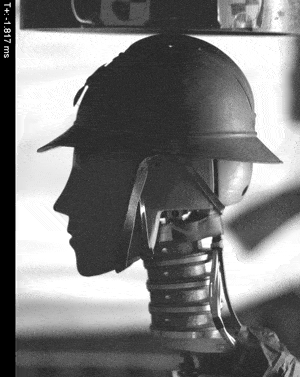D
Deleted member
Guest
To say that this is unexpectedly fascinating is to put it mildly. I admit that as a student of the history of war, sometimes modern wisdom grates on me, like claims of how disabling shock is--because I know the history of how men continued to perform and to survive and remain functional in close proximity to the shock of a heavy shelling and powerful explosives such as mining in the First World War. Now a fascinating study has come out suggesting that, in fact, modern helmets do no better than WWI helmets at preventing shock injuries, and in fact the storied French Adrian helmet may, because its shape disrupts shock-waves, actually outperform modern helmets in certain configurations of shock impact.
WWI helmets protect against shock waves just as well as modern design. French Adrian helmet suggests simple geometry may save brains from overhead blasts.
Biomedical engineers from Duke University have demonstrated that, despite significant advancements in protection from ballistics and blunt impacts, modern military helmets are no better at protecting the brain from shock waves created by nearby blasts than their World War I counterparts. And one model in particular, the French Adrian helmet, actually performed better than modern designs in protecting from overhead blasts.
The research could help improve the blast protection of future helmets through choosing different materials, layering multiple materials of different acoustic impedance, or altering their geometry.

A high-speed video of a French helmet from World War I being bombarded by a shock wave designed to imitate a blast from German artillery shells a few meters away. Credit: Joost Op ‘t Eynde, Duke University
The results were published online on February 13, 2020, in the journal PLOS ONE.
“While we found that all helmets provided a substantial amount of protection against blast, we were surprised to find that the 100-year-old helmets performed just as well as modern ones,” said Joost Op ‘t Eynde, a biomedical engineering Ph.D. student at Duke and first author of the study. “Indeed, some historical helmets performed better in some respects.”
Researchers have only recently begun to study the brain damage a shock wave can cause on its own — and for good reason. Helmets were originally designed to protect from penetrating objects like bullets and shrapnel, and blast waves will kill through pulmonary trauma long before they cause even minor brain damage.
With the advent of body armor, however, soldiers’ lungs are much more protected from such blasts than they used to be. This has caused the incidence of pulmonary trauma following a blast to drop far below that of brain or spine injuries in modern military conflicts, despite the difference in blast tolerance.
While there have been studies that suggest modern helmets provide a degree of protection from shock waves, no currently deployed helmet has been specifically designed for blast protection. And because soldiers today experiencing shock waves while wearing body armor aren’t all that different from soldiers 100 years ago experiencing shock waves while in the trenches, Op ‘t Eynde decided to see if those old designs offered any lessons to be learned.
“This study is, to the best of our knowledge, the first to assess the protective capabilities of these historical combat helmets against blasts,” said Op ‘t Eynde.
Working with Cameron “Dale” Bass, associate research professor of biomedical engineering at Duke, Op ‘t Eynde created a system to test the performance of World War I helmets from the United Kingdom/United States (Brodie), France (Adrian), Germany (Stahlhelm) and a current United States combat variant (Advanced Combat Helmet).
The researchers took turns placing different helmets on a dummy’s head outfitted with pressure sensors at various locations. They then placed the head directly underneath a shock tube, which was pressurized with helium until a membrane wall burst, releasing the gas in a shock wave. The helmets were tested with shock waves of varying strength, each corresponding to a different type of German artillery shell exploding from a distance of one to five meters away.
The amount of pressure experienced at the crown of the head was then compared to brain injury risk charts created in previous studies. While all helmets provided a five-to-tenfold reduction in risk for moderate brain bleeding, the risk for someone wearing a circa-1915 French “Adrian” helmet was less than for any of the other helmets tested, including the modern advanced combat helmet.
